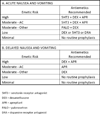Current pharmacotherapy for chemotherapy-induced nausea and vomiting in cancer patients
- PMID: 23496347
- PMCID: PMC3938333
- DOI: 10.1517/14656566.2013.776541
Current pharmacotherapy for chemotherapy-induced nausea and vomiting in cancer patients
Abstract
Introduction: Nausea and vomiting are two of the most frequent and troubling side effects patients experience during chemotherapy, interfering with compliance with cancer therapies and quality of life. While newly available treatments have improved our ability to manage nausea and vomiting, anticipatory and delayed nausea and vomiting are still major problems for patients receiving chemotherapy. Many cancer patients consider delaying future chemotherapy cycles and some contemplate stopping chemotherapy altogether because of their fear of experiencing further nausea and vomiting.
Areas covered: The purpose of this article is to provide an overview of the pathopsychophysiology of chemotherapy-induced nausea and vomiting (CINV), the recommended guidelines for treatment, and current agents in late-stage clinical trials, and future research needs to address the continued challenges of treatment-related nausea and vomiting.
Expert opinion: Despite advances in pharmaceutical and behavioral therapies, and the provision of standard clinical guidelines for effectively managing CINV, patients continue to experience it. Moreover, control of nausea, acute and delayed, and anticipatory nausea and vomiting remains an important, unmet need among cancer patients. It is critical to focus attention on better understanding the mechanisms underlying nausea, anticipatory symptoms and delayed symptoms.
Figures


References
-
- Hofman M, Morrow GR, Roscoe JA, et al. Cancer patients' expectations of experiencing treatment-related side effects: a University of Rochester Cancer Center--Community Clinical Oncology Program study of 938 patients from community practices. Cancer. 2004;101:851–857. - PubMed
-
- Hickok JT, Morrow GW, Roscoe JA, Pierce HI, Rosenbluth RJ. Prevalence and severity of acute and delayed NV association with 3 highly emetogenic chemotherapies. [abstract] Supportive Care in Cancer. 2001;9:289.
-
- Grunberg SM. Antiemetic activity of corticosteroids in patients receiving cancer chemotherapy: dosing, efficacy, and tolerability analysis. Annals of Oncology. 2007;18:233–240. - PubMed
-
- Aapro MS, Molassiotis A, Olver I. Anticipatory nausea and vomiting. Support Care Cancer. 2005;13:117–121. - PubMed
Publication types
MeSH terms
Substances
Grants and funding
LinkOut - more resources
Full Text Sources
Other Literature Sources
Medical
